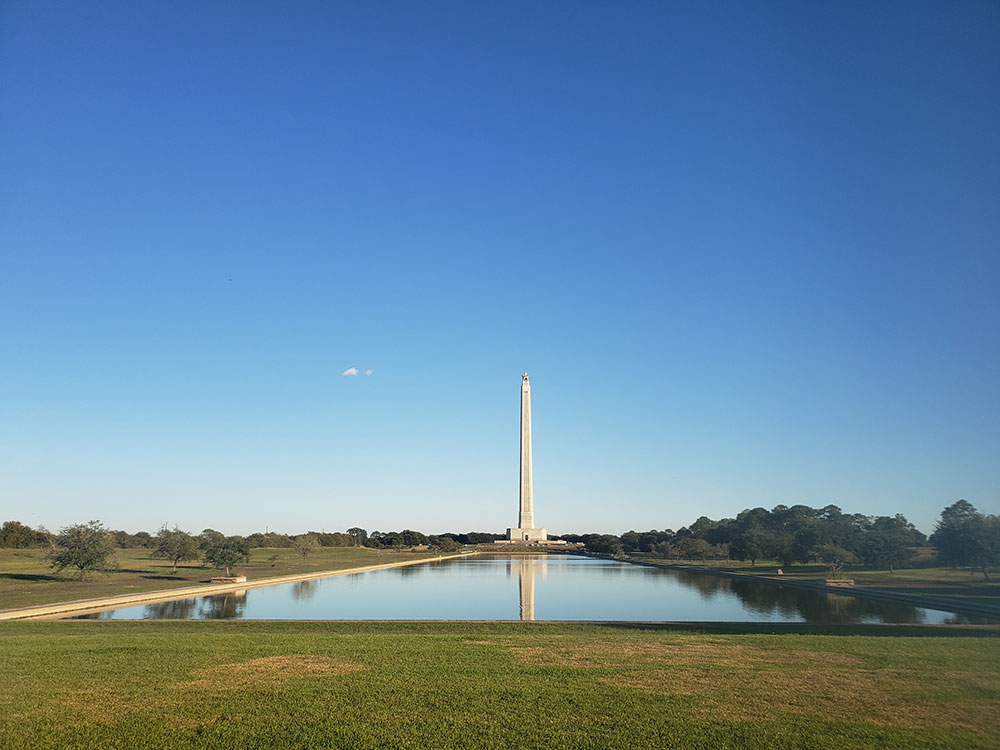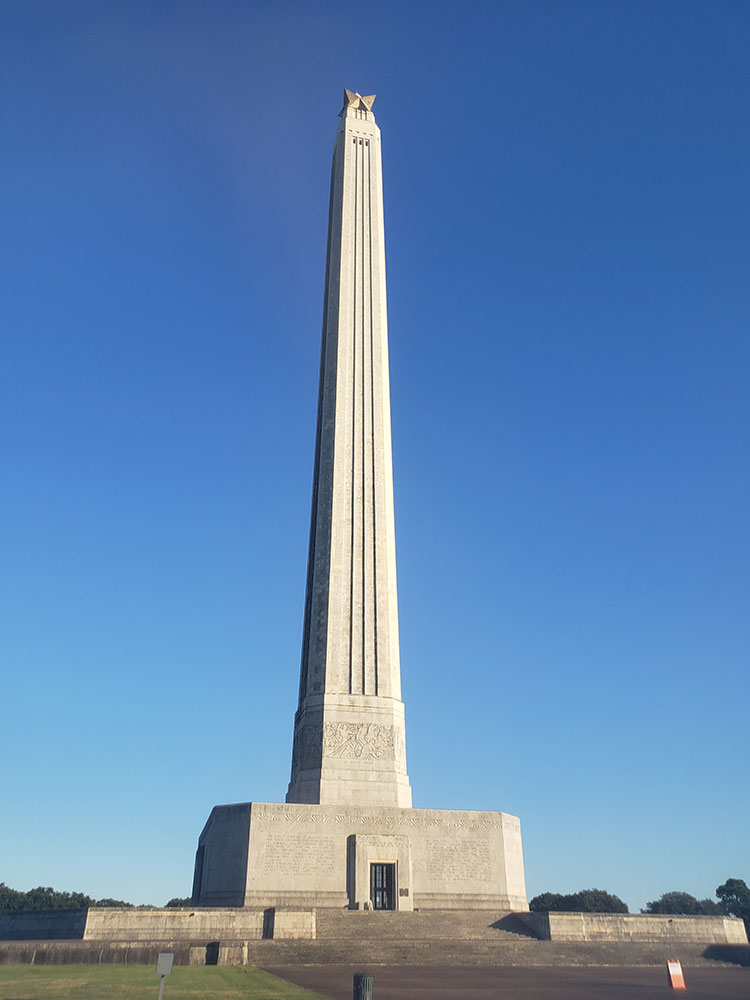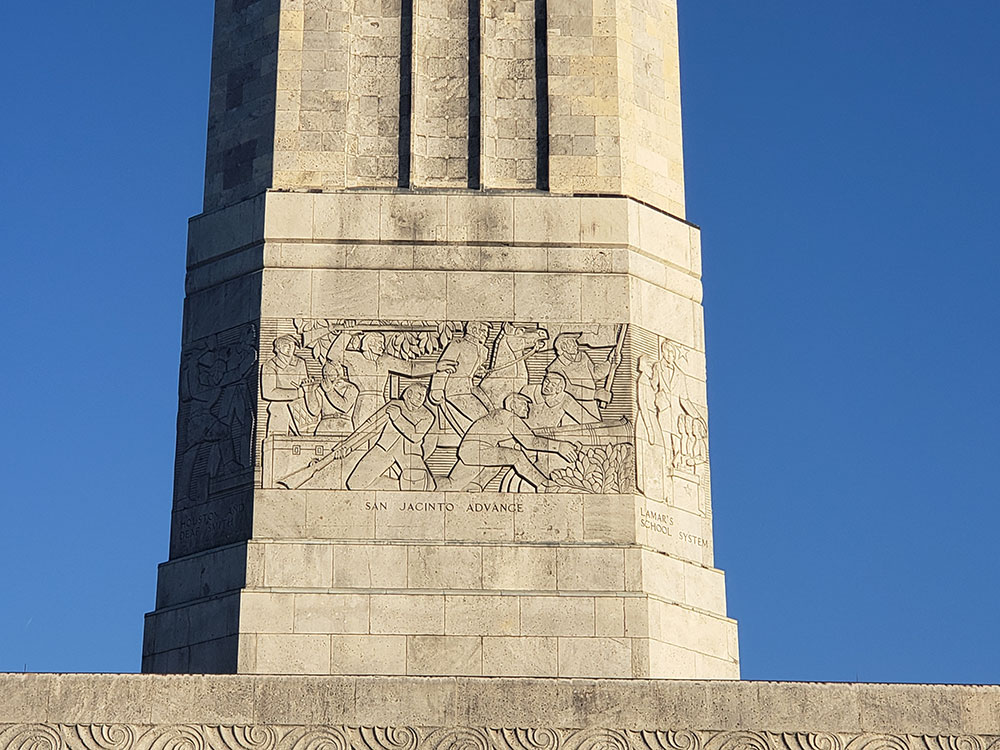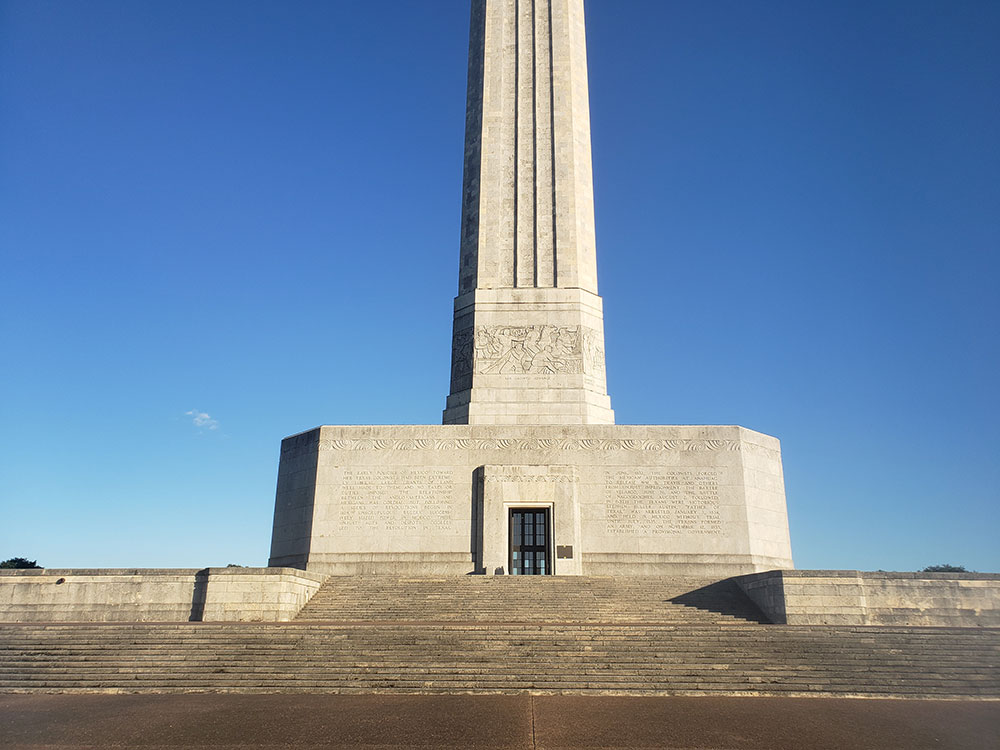General Information
The San Jacinto Battleground State Historic Site includes the location of the Battle of San Jacinto and the museum ship USS Texas. It is located off the Houston Ship Channel near the city of Houston. The site was designated a National Historic Landmark in 1960.
A prominent feature of the park is the San Jacinto Monument. Visitors can take an elevator to the monument's observation deck for a view of Houston, the Houston Ship Channel and USS Texas.
The beginnings of the San Jacinto Battleground State Historic site trace to the early 1880s, when the State of Texas purchased ten acres along Buffalo Bayou in preparation for the fiftieth anniversary of the Texas Revolution. The Daughters of the Republic of Texas (DRT) pressured the Texas Legislature for more appropriations for San Jacinto. In 1897, Texas State Senator Waller Thomas Burns of Houston helped to pass legislation to fund $10,000 to establish a public park. The money was used to purchase an additional 336 acres of land at San Jacinto. The state appropriated another $25,000 in 1907 for improvements at the battleground and officially named it San Jacinto State Park, the first official state park in Texas. A governor appointed local commission managed the park and reported to the State Board of Control. More state-assisted improvements came to the park in preparation for the 1928 Democratic National Convention in Houston.
The San Jacinto Museum of History is located inside the base of the San Jacinto Monument. In addition to the Battle of San Jacinto, the museum's exhibits focus on the history of Texan culture, including Mayan, Spanish and Mexican influences, the history of the Texas Revolution and the Republic of Texas, and important figures in Texas history.
The 160-seat Jesse H. Jones Theatre for Texas Studies presents a 35-minute movie titled Texas Forever!! The Battle of San Jacinto. Texas was the first battleship memorial museum in the US. When the battleship was presented to the State of Texas, she was commissioned as the flagship of the Texas Navy.
On 17 March 1948, Texas began her journey to her new anchorage along the busy Houston Ship Channel near the San Jacinto Monument, at San Jacinto State Park, arriving on 20 April, where she was turned over to the State of Texas the next day to serve as a permanent memorial.
The San Jacinto Monument is a 567.31-foot-high (172.92-meter) column located on the Houston Ship Channel near the city of Houston. The monument is topped with a 220-ton star that commemorates the site of the Battle of San Jacinto, the decisive battle of the Texas Revolution. The monument, constructed between 1936 and 1939 and dedicated on April 21, 1939, is the world's tallest masonry column and is part of the San Jacinto Battleground State Historic Site. By comparison, the Washington Monument is 554.612 feet (169.046 m) tall, which is the tallest stone monument in the world. The column is an octagonal shaft topped with a 34-foot (10 m) Lone Star – the symbol of Texas. Visitors can take an elevator to the monument's observation deck for a view of Houston and the Battleship Texas.
The San Jacinto Museum of History is located inside the base of the monument and focuses on the history of the Battle of San Jacinto and Texas culture and heritage. The San Jacinto Battlefield, of which the monument is a part, was designated a National Historic Landmark on December 19, 1960, and is therefore also automatically listed on the National Register of Historic Places. It was designated a Historic Civil Engineering Landmark in 1992.
In 1856, the Texas Veterans Association began lobbying the state legislature to create a memorial to the men who died during the Texas Revolution. The legislature commemorated the final battle of the revolution in the 1890s, when funds were appropriated to purchase the land where the battle took place. After a careful survey to determine the boundaries of the original battle site, land was purchased for a new state park east of Houston, in 1897. This became San Jacinto Battleground State Historic Site.
The Daughters of the Republic of Texas began pressuring the legislature to provide an official monument at the site of the Battle of San Jacinto. The chairman of the Texas Centennial Celebrations, Jesse H. Jones, provided an idea for a monument to memorialize all Texans who served during the Texas Revolution. Architect Alfred C. Finn provided the final design, in conjunction with engineer Robert J. Cummins. In March 1936, as part of the Texas Centennial Celebration, ground was broken for the San Jacinto Monument. Construction began on April 21, 1936, the centennial anniversary date of the Battle of San Jacinto. The cornerstone was set one year later on April 21, 1937, and two years later construction ended, also on the anniversary date, April 21, 1939. Jesse H. Jones was in attendance along with the commencement ceremony in 1939 when he and Sam Houston's last surviving son, Andrew Jackson Houston, and others officially dedicated the monument.
The San Jacinto monument is an octagonal column and primarily constructed of reinforced concrete. Its exterior is faced with Texas limestone from a quarry near the Texas State Capitol. It stands 567.31 feet (172.92 m) tall and is the tallest monument column in the world. It is 9.6 feet (2.9 m) taller than the next tallest, the Juche Tower in North Korea.
The base of the monument contains a 15,625-square-foot (1,451.6 m2) museum and a 160-seat theater. The base is decorated with eight engraved panels depicting the history of Texas. The bronze doors which allow entry into the museum show the six flags of Texas. At the point where the shaft rises from the base, it is 48 feet (15 m) square (2,304 square feet (214.0 m2)). The shaft narrows to 30 feet (9.1 m) square (900 square feet (84 m2)) at the observation deck. At the top of the monument is a 220-ton, 34-foot (10 m) high star, representing the Lone Star of Texas. A 1,750-by-200-foot (533 by 61 m) reflecting pool shows the entire shaft.
USS Texas (BB-35) is a museum ship and former United States Navy New York-class battleship. She was launched on 18 May 1912 and commissioned on 12 March 1914.
Texas saw action in Mexican waters following the "Tampico Incident" and made numerous sorties into the North Sea during World War I. In World War II, Texas escorted war convoys across the Atlantic and later shelled Axis-held beaches for the North African campaign and the Normandy Landings before being transferred to the Pacific Theater late in 1944 to provide naval gunfire support during the Battles of Iwo Jima and Okinawa. Texas was decommissioned in 1948, having earned a total of five battle stars for service in World War II. It is a (presently closed) museum ship near Houston, Texas.
Texas was also a technological testbed: the first US battleship to mount anti-aircraft guns, the first US ship to control gunfire with directors and range-keepers, the first US battleship to launch an aircraft, and one of the first US Navy ships to receive production radar.
Texas was the first US battleship to become a permanent museum ship, the first battleship declared to be a US National Historic Landmark, and is the only remaining World War I era dreadnought battleship. She is also one of the eight remaining ships and the only remaining capital ship to have served in both World Wars.
This article uses material from the Wikipedia article "San Jacinto Battleground State Historic Site", "San Jacinto Monument", and "USS Texas (BB-35)", which is released under the Creative Commons Attribution-Share-Alike License 3.0



